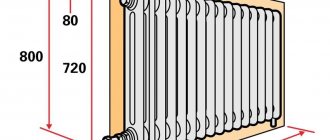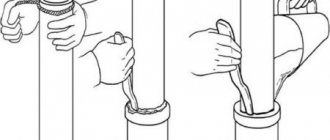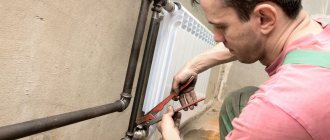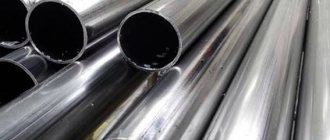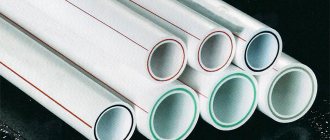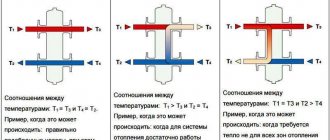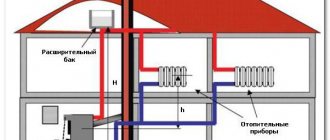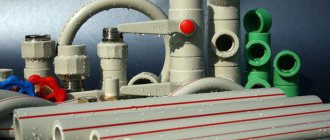You can make a good renovation, order expensive furniture, hang exclusive curtains, but kill all this beauty with the sight of a plastic or steel riser climbing along the wall.
This problem is familiar to many people doing renovations. How to hide heating pipes and radiators is almost the main headache for owners of new apartments.
Disguise methods
There are many ways to close heating pipes in a private house or apartment. The most radical is to hide them altogether, the least is to decorate them with decorations.
At the same time, in individual heating systems, the volume of heat will be distributed between radiators and pipes, and in apartments with central heating, pipe insulation often results in heat loss. But there are ways to avoid this problem.
Place inside walls or floors
Pipes can be hidden inside walls or floors. It is very convenient and aesthetically pleasing. To lay the main line, a groove is made, the pipes are wrapped in heat-insulating material and laid in a recess in the wall, then it is sealed or covered with plasterboard.
All connections and valves should under no circumstances be walled up in the wall - in the event of a breakthrough, it will have to be broken down. Old pipes cannot be insulated in this way.
Hide in a box
Another way is to place the pipeline in a plasterboard box on a metal profile. The box can be painted, plastered, covered with wallpaper - this gives a huge selection of options for decorating heating pipes. You can choose perforated metal - it looks stylish and has good heat dissipation. It is also possible to hide the gas line under a ready-made plastic box.
If plastic is chosen for masking, it must be of proper quality: some types of this material turn yellow and swell when heated, so it is necessary to clarify its technical characteristics.
It is important to remember the rules: the pipe must be at least 5 cm from the walls of the box, and it is also necessary to provide access to taps and fittings.
Painting and decorating
The pipeline is painted with paint, matching it to the color of the walls or, conversely, in contrast. Decorate the risers with a tourniquet and rope. Sometimes a bamboo outline is made for them. Later, appliqués made of paper, leather or fabric can be placed on top - this is a decoupage technique that is widespread in modern design.
It is necessary to paint heating elements only when they are in a cold state - when the heating is turned off. Rapid heating may cause the paint to crack.
Disguise with furniture
Disguising it with furniture is the easiest way: push the riser with a cabinet - and no money or hassle. This is convenient to do in the kitchen and bathroom, where furniture is most often placed around the perimeter of the room close to the walls. Special holes are made in the back and side walls of kitchen cabinets.
At the same time, in living rooms it is problematic to disguise pipes with furniture: risers and radiators are located, as a rule, on the wall where the window is, and you can’t put a cabinet there.
Close with screen
Decorative screens are a great way to hide not only risers, but also radiators. The screen can be made of glass or transparent plastic, or even designed in the form of a stained glass window - beautiful, intriguing, stylish. If there is lighting, it will add mood to the interior and can serve as a night light.
To avoid problems with heating, there is an option to make decorative grilles through which heat will still flow. In this case, all screens must be removable.
Prices for screens for radiators
screens for heating radiators
Construction of a false wall
A false wall also allows you to hide all communications from view. Behind the artificial wall, not only heating risers can pass, but also a gas main, electrical wires, and a coaxial cable for a TV.
You just have to remember that a false wall reduces the space of the room. And some elements cannot be left without access. For example, gas workers are very unhappy when they try to hide a gas pipe.
Hide behind a suspended ceiling
This method is not so popular. However, in a private house it can be used if the heating distribution of the first floor is made under the ceiling, and the second floor - under the floor. In this case, a suspended ceiling is installed. Although, for all its practicality and elegance, it also reduces the space of the room, this time the height.
Prices for different types of suspended ceilings
suspended ceiling
How to hide heating pipes in a private house
The owner of a residential building can independently decide on changes to the heating system design. There are only a few restrictions, in the form of recommendations related to the installation standards described in SNiP and GOST:
- It is not recommended to bury the pipeline in concrete;
- Pipes can be laid inside the wall: stainless steel, copper made of cross-linked polyethylene, metal-plastic, provided that the connections are made by pressing;
- Be sure to use a heat-insulating casing (Merilon).
There are no other restrictions regarding how you can hide heating pipes in a private house. The owner of the house has the right to independently decide what material to use during installation work, as well as how exactly to hide the pipeline. As for an apartment building, the standards described in the housing code, technical specifications and SNiP apply.
How to make a plasterboard box with your own hands
A plasterboard box is the most acceptable option for those who decide to hide the batteries themselves. It is easy to make with your own hands - you do not need to have much construction experience to do this.
Required tools and materials
All the necessary components are easy to find in construction stores.
The following materials and tools will be required:
- plasterboard sheets;
- metallic profile;
- scissors or hacksaw for drywall;
- self-tapping screws, screws and dowels for fastening to the wall - the type must be selected in accordance with the material;
- building materials for further finishing: putty, primer, coating;
- plinth (from the same material that is already on the walls, or vice versa, differs in style, but is in harmony).
Considering that this will be a lightweight structure, not burdened by anything, it is permissible to use an aluminum single profile. In addition to the standard plinth, special plugs, linings, and rings are possible.
Step 1: Preparation
Before starting work, you need to measure the coverage of the tubes, calculate tolerances, and draw up a drawing. After this, start cutting the profile.
If the distance between the posts is more than 250 mm, additional posts must be prepared. If the height of the rack is more than 1500 mm, prepare horizontal jumpers. After this, the drywall is cut.
Step 2: Profile Installation
The metal profile is attached to the floor using self-tapping screws, and to the walls also using dowels that create a sleeve for the self-tapping screws.
Today, there are various types of dowels designed for use in brick, plasterboard or concrete walls. If the structure turns out to be too massive, then the guides need to be strengthened. Using transverse elements, a sheathing is created.
Step 3: Drywall
The edges of the cut sheets of gypsum board (plasterboard) are processed with a plane and then the elements are screwed to the frame. The joints are sealed with putty. Special windows are cut out opposite the places where the taps are located.
Step 4: Final Finish
After the box has dried, you can begin the final finishing. It is puttyed, primed, and then the desired coating is applied: wallpapered, plastered or painted. Technical windows can be closed with plastic doors that match the color, or with easily removable grilles.
Step 5: baseboard
To complete the work, plinth or other decorative trims are installed on the floor and ceiling.
The best ways to beautifully hide radiators
There are several ways to hide batteries; in this section we will look at the most popular and effective ones.
Hinged screen
It is by far the most practical and popular method; most often this design is made of metal and has its advantages:
- simple installation;
- heat exchange remains the same;
- can be made with rounded corners, which reduces the risk of injury.
Glass screens
A screen made of glass will be an interesting and stylish solution, especially for those who choose minimalism or a modern style in interior design. Photo printing or various patterns can be applied to the glass, but this method is not a budget option. Installation is carried out on a screw holder, but you will have to drill holes in the wall. However, the heating radiator will be stylishly protected. This option will fit into any interior.
Box screens
Box screens are an excellent option for decorating radiators.
- They will help to completely hide the battery.
- The box can become a piece of furniture.
- Erans are easy to install and easy to care for.
- Protect from burns or other injuries.
The photo shows an original green wooden box in the children's interior.
Curtains to the floor
Let’s not forget about the most popular way to hide batteries - simply hang them with opaque or translucent curtains. Using this method, over time you will even forget that there are pipes and a radiator behind the curtains. The main thing is to choose curtains that will look harmonious and not show everyone that there is something behind them.
Painting the walls in color
How to hide a heating radiator on the wall if other designs are “prohibited”. There is only one way to paint it the same color as the wall.
Wood frame
Wood will create coziness and warmth in the apartment, and the disguise of the battery will be elegant and beautiful. This option is for those who are furnishing their home in eco-style using natural materials. These ways to hide batteries can be used as a stand for home decor.
In the photo, ordinary wooden blocks stylishly hide the radiator in the kitchen.
Built in furniture
Another common way to cover a radiator is custom-made furniture or built-in furniture (shelves, cabinets, folding tables, seating).
Hide the radiator with furniture
Arrange furniture, such as an armchair or desk, so that it covers the radiator. A cast iron radiator is not attractive to many, but pieces of furniture can hide it.
Replace with designer model
For those who don’t want to invent anything, unique designer ways to hide batteries have been developed that already initially have a beautiful appearance and you simply don’t want to hide them.
Original ideas
There are many creative ideas that can turn batteries into a decorative element:
- Forged products
- Hide the radiator with fabric
- Painting and decoupage of batteries
In the photo, with the help of a beautiful painting, the battery has merged with the wall.
How to hide behind plastic panels
In crowded places (in public places) or in the bathroom, a plastic box is quite appropriate. If the repair is done at the same time as masking the pipes, then the material chosen for the walls is used. This is both economical and 100% fulfills the purpose of camouflage.
Fastening the frame
To fix the frame, wooden or metal bars (profiles) are installed on the floor and walls, onto which plastic panels will be attached. Transverse elements are screwed to the profiles. Thus, a crate is created. It is advisable to make it at least 40 x 40 mm in size.
Paneling
After installing the frame, you can proceed to paneling. Plastic sheets, cut to size, are screwed with special small nails or glued with glue. You can use a construction stapler.
Upon completion, the joints with cut edges are closed with special elements, and the entire product takes on a neat appearance.
Using drywall to mask pipes
The most common method is to cover heating pipes with plasterboard. Both in the room and in the kitchen, around a horizontal or vertical riser, you can build a frame from galvanized profiles or wooden beams and cover it with plasterboard. There are two options for using this material: creating a box or false wall.
Drywall is the simplest solution for masking pipes
Whether to cover the heating pipe with plasterboard can be decided based on the following wishes:
- Before hiding metal-plastic pipes in a box or behind a false wall, which are connected using dismountable fittings, they should be replaced with press fittings.
- If the pipeline is old, it should be replaced before hiding the heating pipes in the kitchen or room.
- Pipes made of copper and steel should be covered with heat-insulating material.
- Polypropylene pipes should not be covered at all.
- In places where couplings, tees, and corners are installed, special doors should be made, especially in the kitchen, for quick access to them in the event of an accident.
The advantages of using drywall are the low cost of work, the availability of materials, the ability to quickly access pipes, and the easy dismantling of the drywall structure if necessary. A false wall is constructed according to the same principle as a box, but takes away some area from the room. Then you can lay tiles on it, cover it with wallpaper, and decorate it.
Helpful advice: It is recommended to use a cutter when hiding pipes with drywall, which will avoid the appearance of unevenness on its surface.
Decorative overlays
The junction of a pipe or plasterboard (plastic) box with the floor and ceiling is the most vulnerable: it is impossible to cut the edge so smoothly or lay down the floor covering.
When laying laminate flooring, it is even recommended to leave cutouts around the heating risers to avoid deformation of the flooring material itself when heated.
Therefore, decorative overlays are used to hide this unsightly place.
Advantages of use
Firstly, the overlays not only mask the joints, but also additionally decorate the room. Secondly, the practical benefits of the pads are obvious: during general cleaning or cosmetic repairs, they can be easily removed and then returned to their place.
Material of manufacture
As for the material, it is recommended to opt for wood. The service life of a wooden part is 10 years, in contrast to its counterpart made of MDF (medium density fiberboard) - it will last only 5 years.
The holes in the cover must exactly match the diameter of the pipe or the shape of the box, otherwise the whole point of this decoration will be lost. You can also consider plastic overlays.
Recommendations for decor installation
As a rule, these decorative trims consist of two parts, which are separated and, after installation around the heating element, snapped back together. After the decorative parts are installed, they are glued to the floor or ceiling.
Installation of this system is very simple and takes less than a minute. This decor can then be easily removed.
Options for decorative masking of pipes
If you want to hide heating pipes without undertaking major repairs, then this can be done using decorative interior design techniques.
Wall panels
Decorative removable panels are made from various materials. It can be glass, plastic, metal, wood, fabric or leather on a rigid frame. You can order such panels according to your own sizes, or you can purchase standard ones.
Advantage of using removable panels:
- communications remain accessible, but are not visible;
- the panel can be changed with a change in interior or mood;
- They are easy to care for.
Note! Metal panels or screens have an attractive appearance and do not lead to heat loss.
Interior decor
You can hide heating pipes by using them as a piece of furniture. For decoration, natural materials, artificial flowers, and curtains are used.
- Natural motives. The design of pipes to resemble a tree trunk, vine, or reed looks impressive. To do this, the pipe is lined with matting, wrapped with hemp or similar material of natural color and texture. Then they decorate with flowers, birds, ceramic dishes, etc.
- Stylization as a support or canopy for shelves, decorative interior elements of the corresponding style.
- In rooms decorated with tiles, pipes are masked with covers with pebbles, shells, and elements stylized in a marine style.
Ways to decorate old pipes
Under no circumstances should old pipes be walled up or sewn into boxes due to the high risk of leaks. However, here it is also possible to show your imagination by decorating your home.
Painting
You can paint the heating elements the same color as the walls so that they blend into the overall background. Or you can choose a contrasting color, making a bright spot - the style dominant of the room.
In any case, the paint must be heat-resistant and non-toxic, and should not emit harmful fumes when heated. Acrylic and alkyd, as well as water-dispersion paints, are suitable for this.
Ropes and cords
You can use jute rope or rope. This method of decoration looks stylish, emphasizing the image of the entire room, expressed in a rustic, colonial loft.
The main thing is that the material can withstand high temperatures. After this, it can be decorated with artificial paper flowers or other elements.
Bamboo panels
Another material for decorating old elements is bamboo. Bamboo panels should also be decorated additionally, for example, by planting a small toy panda or an exotic bird.
Methods for decorating heating pipes
Suppose that your apartment has old heating systems that are inappropriately located heating pipes: the design of such objects can only be limited by your imagination and material capabilities. We list a few of the simplest and most accessible ways for everyone to show their creative individuality:
- The simplest solution is to simply paint the protruding pipe in the color of the wall.
- Decorating will require a little more investment - both labor and time.
- The most time-consuming part is undoubtedly the attempt to hide pipes behind furniture or to build a simple structure specifically for this purpose.
You can make decorative boxes for heating pipes from any suitable material that will correspond to the design idea for decorating the room:
- drywall;
- wall panels made of polyvinyl chloride or MDF;
- laminate;
- parquet board on a slatted frame.
The most popular is drywall. This material allows you to create structures of various configurations. Read about the features of its installation in the article “How to hide heating pipes.”
You can decorate a plasterboard structure that hides pipes quite easily by painting it, for example, in the color of the walls or by gluing wallpaper.
Installation of pipes in the wall
The installation of risers in the wall must be approached with all responsibility. First of all, you need to be sure that the pipes will not leak. And you definitely can’t brick up the connections.
Step 1: calculation
For polymers, the so-called linear expansion reaches 5 mm, so it is necessary to provide a sufficient number of expansion joints. The size of the grooves is calculated based on the diameter of the pipe, the thickness of the insulating material, and the volume of mortar.
Step 2: installation
A recess is made in the wall according to the calculations made. In this groove, vertical and horizontal brackets are installed along the entire height. A riser wrapped in a heat-insulating casing is mounted on them.
Step 3: system connection and testing
Before sealing the grooves, it is necessary to connect and check the main line. If everything is in order, the hole is sealed.
Step 4: Mapping
Upon completion of the work, an as-built diagram must be drawn up showing where the route goes. It is needed to avoid damage to the pipeline as a result of minor repairs.
Sealing pipes in the floor
Laying pipes in the floor using technology is not much different from embedding a pipeline in a wall. But there are some nuances here. Depending on its location, the system can play the role of a warm floor or, at least, a warm baseboard. This type of heating has great advantages: it heats the walls evenly. Thus, you can insulate the coldest wall on which the window is located.
It is important to remember that the concrete screed must be thick enough so as not to break if the place where the route runs is accidentally stepped on.
Installation of pipes in the floor is carried out when laying the heating system.
The step-by-step list of works is as follows:
- A groove is made in the floor, the depth of which is calculated taking into account the thermal insulation material and mortar. It is important that the top edge of the pipe does not exceed the floor level.
- The pipeline in the casing is laid in a groove.
- The system is being tested.
- The groove is sealed with concrete.
- The flooring material is laid on top.
In this system, if it is produced in a private house, it is worth providing a circulation pump, because in horizontal pipes the flow of water slows down. It is also worth remembering that if there is a breakthrough, you will have to break the floor. And of course, you need to have an executive diagram of the work in order to know the location of the line in the floor.
How to hide heating pipes 3 simplest and most effective ways
An open pipeline is unlikely to decorate any interior, so many people ask experts on forums how to hide heating pipes in an apartment or house to make the home design look more attractive? There are several options for solving this problem, which I will tell you about below.
Example of a hidden heating system
Options for masking pipes
Among all the possible methods, the three most effective options for masking pipes should be highlighted:
Let's look at the features of each of these methods.
Option 1: hide pipes in the floor and walls
Before I tell you how pipes are walled up in walls or hidden in the floor, I will give a few important rules that must be followed:
- Only new pipelines can be hidden in the floor or walls. Do not try to hide old lines, as problems may arise later;
- Plastic pipes expand greatly when exposed to high temperatures. This is especially true for polypropylene, the linear expansion of which reaches 5 mm per meter. Therefore, during the installation of the pipeline it is necessary to provide the required number of compensators;
- before hiding heating pipes made of metal-plastic or metal, you need to put heat-insulating casings on them, which will reduce heat loss;
- Regardless of the material from which the pipeline is made, detachable fittings should not be walled up so that they remain freely accessible.
Hidden installation of pipes in walls
The process of laying pipes in walls is carried out in the following sequence:
- first of all, you need to draw up a wiring diagram and, in accordance with it, mark the location of pipes on the walls;
- Then, according to the markings, you need to make the channels yourself. To do this, you can use a hammer drill with a chisel turned on in impact mode;
- To securely fix the pipes, holders or brackets are installed in the grooves. To install the latter, dowel nails should be used;
- then heat-insulating casings are put on the pipes, which can be secured with plastic clamps, after which the pipeline is installed in grooves;
- After assembling the heat pipe, it must be pressure tested (checking its operation under pressure), which makes it possible to identify leaks and immediately eliminate them;
- At the end of the work, the grooves are sealed with cement mortar. For better adhesion of the composition, they must first be cleaned of dust and primed.
The grooves must be made taking into account the thickness of the insulation and the sealing mortar.
Installation of heating pipes in the floor
Hiding the heating pipe in the floor is even easier. As a rule, pipes are laid on the base before screeding, and then filled with concrete. In this case, heat-insulating covers are also used, and pressure testing of the system is mandatory.
If you do not plan to pour a screed on the floor, the pipes can be laid in the space between the joists and the subfloor. To beautifully decorate the place where pipes enter and exit the floor, special pipe covers are used.
It must be said that after installing the pipeline, it is imperative to draw up an executive diagram on which the locations of the pipes are indicated. This is necessary so that during subsequent home repairs the integrity of the heating system is not compromised.
Example of a riser box
Option 2: install the frame
Installation of heat pipes in grooves is the most optimal solution. However, if the system is already installed, then it can only be hidden using a box. You can make the latter from the following materials:
To make a box you need to prepare the following materials and tools:
Ways to hide pipes in the bathroom
In a bathroom or toilet, as a rule, there is a main transit pipe (a water heating riser through which water rises to the expansion tank or, conversely, goes down, depending on the type of wiring - upper or lower). There may also be a drain pipe in the toilet.
To hide or decorate these usually ugly pipes, the following methods are used:
- A special cabinet is built in the toilet, in which, in addition to shelves, there are also systems - a water heating riser, a gas system (if the toilet is located next to the kitchen). There they also make apartment-by-apartment water distribution and install meters.
- Install a plasterboard box. It should be remembered that drywall must be moisture resistant. And if you plan to lay tiles on top, then a reinforced profile should be installed - the structure with tiles is very heavy.
- Finally, the pipes can be simply painted, implementing a bold design solution.
There are a lot of design ideas for decorating pipes in the bathroom, so it is not necessary to use the loft style if the pipes create an unsightly appearance.
Masking joints
The entry points of the heating pipeline into the living space are considered to be particularly problematic in terms of decoration and camouflage. Even neat cuts of coverings look out of place in the interior and can spoil the impression of the most elegant and thoughtful design of the decor.
The exit points of the heating system pipes need to be masked, regardless of the type of coating and the quality of the cuts Source homemasters.ru

